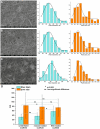Effect of Sterilization Methods on Electrospun Scaffolds Produced from Blend of Polyurethane with Gelatin
- PMID: 36826869
- PMCID: PMC9959520
- DOI: 10.3390/jfb14020070
Effect of Sterilization Methods on Electrospun Scaffolds Produced from Blend of Polyurethane with Gelatin
Abstract
Fibrous polyurethane-based scaffolds have proven to be promising materials for the tissue engineering of implanted medical devices. Sterilization of such materials and medical devices is an absolutely essential step toward their medical application. In the presented work, we studied the effects of two sterilization methods (ethylene oxide treatment and electron beam irradiation) on the fibrous scaffolds produced from a polyurethane-gelatin blend. Scaffold structure and properties were studied by scanning electron microscopy (SEM), atomic force microscopy (AFM), infrared spectroscopy (FTIR), a stress-loading test, and a cell viability test with human fibroblasts. Treatment of fibrous polyurethane-based materials with ethylene oxide caused significant changes in their structure (formation of glued-like structures, increase in fiber diameter, and decrease in pore size) and mechanical properties (20% growth of the tensile strength, 30% decline of the maximal elongation). All sterilization procedures did not induce any cytotoxic effects or impede the biocompatibility of scaffolds. The obtained data determined electron beam irradiation to be a recommended sterilization method for electrospun medical devices made from polyurethane-gelatin blends.
Keywords: electron beam irradiation; electrospun scaffold; ethylene oxide; gelatin; polyurethane; protein; sterilization.
Conflict of interest statement
The first two authors should be regarded as joint first authors. Other authors declare no conflict of interest. The funders had no role in the design of the study; in the collection, analyses, or interpretation of data; in the writing of the manuscript; or in the decision to publish the results.
Figures





References
Grants and funding
LinkOut - more resources
Full Text Sources
Miscellaneous

